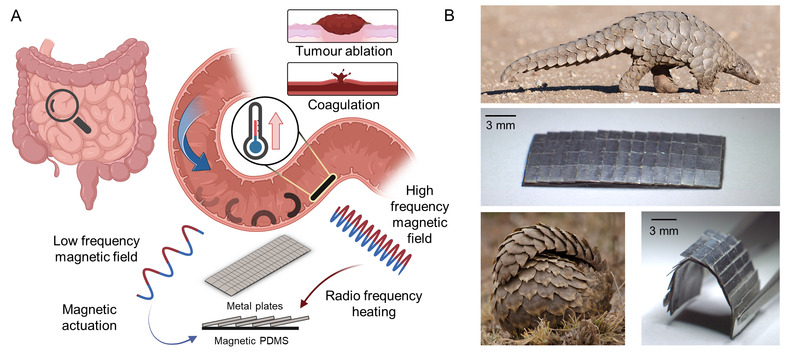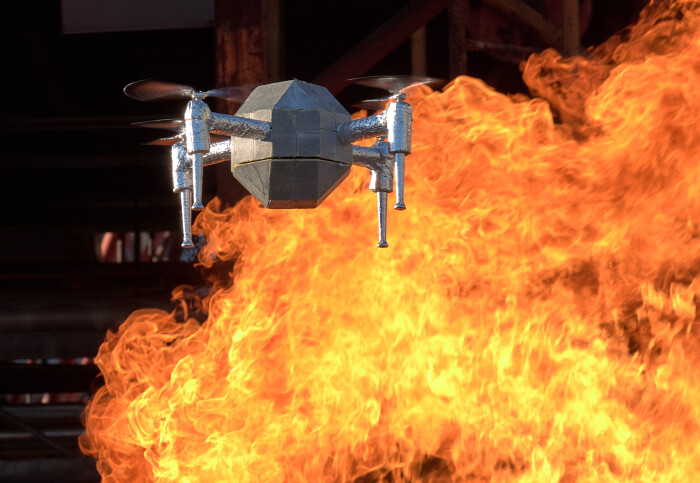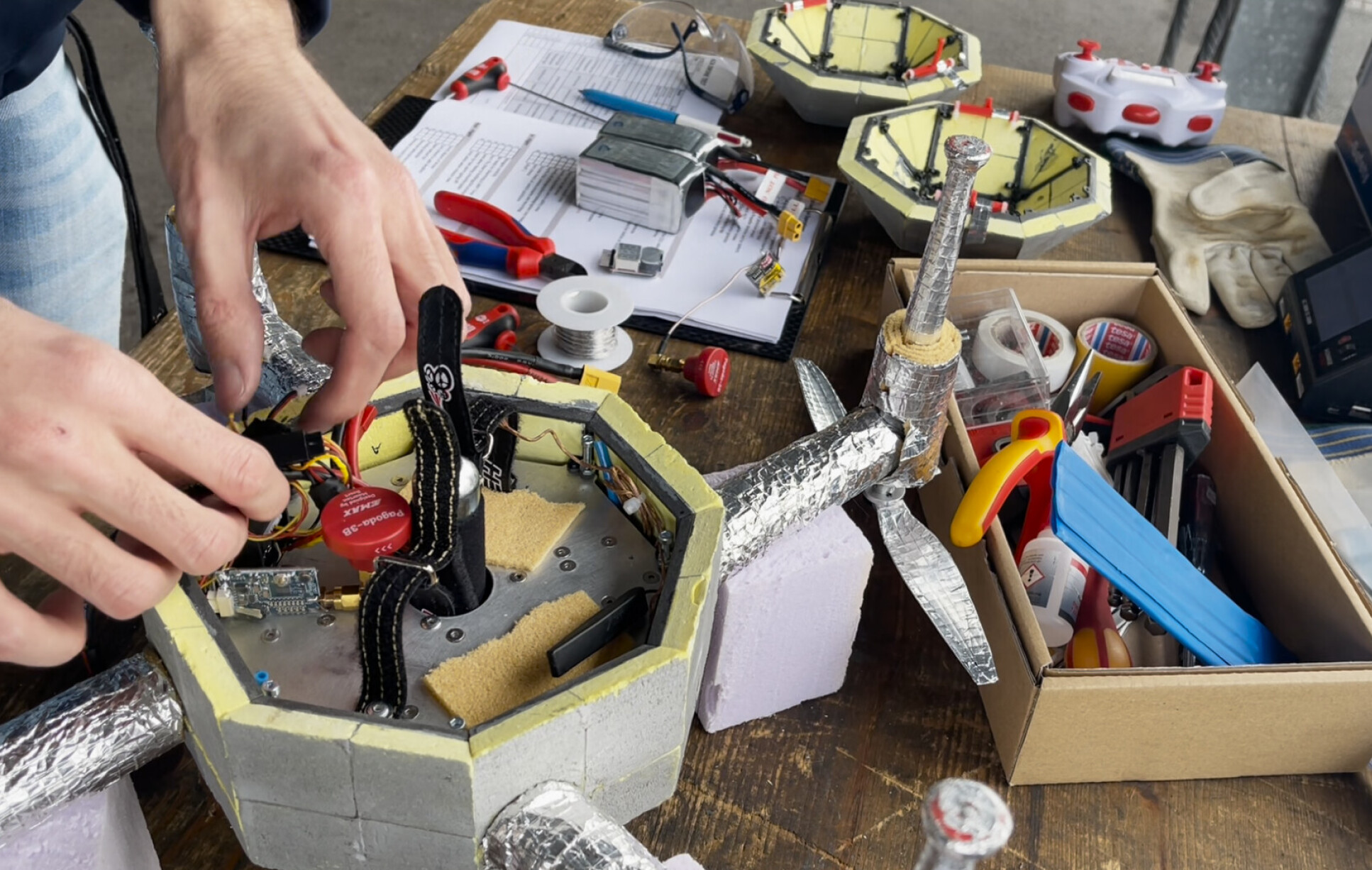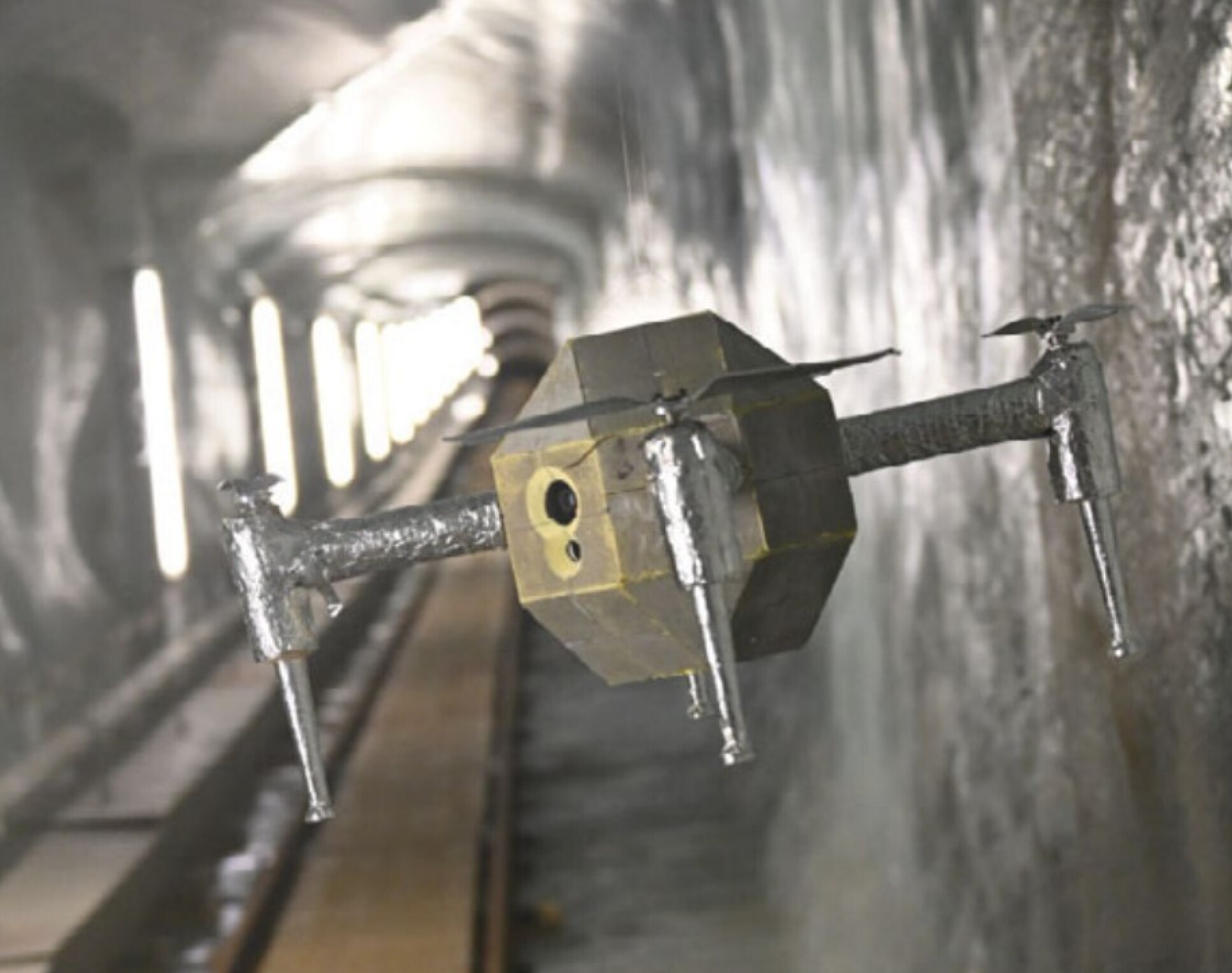RT-2: New model translates vision and language into action
Research improves quadruped bounding with efficient learning method
Researchers develop low-cost sensor to enhance robots’ sense of touch
Pangolin the inspiration for medical robot

Scientists at the Max Planck Institute for Intelligent Systems in Stuttgart have developed a magnetically controlled soft medical robot with a unique, flexible structure inspired by the body of a pangolin. The robot is freely movable despite built-in hard metal components. Thus, depending on the magnetic field, it can adapt its shape to be able to move and can emit heat when needed, allowing for functionalities such as selective cargo transportation and release as well as mitigation of bleeding.
Pangolins are fascinating creatures. This animal looks like a walking pine cone, as it is the only mammal completely covered with hard scales. The scales are made of keratin, just like our hair and nails. The scales overlap and are directly connected to the underlying soft skin layer. This special arrangement allows the animals to curl up into a ball in case of danger.
While pangolins have many other unique features, researchers from the Physical Intelligence Department at the Max Planck Institute for Intelligent Systems in Stuttgart, which is led by Prof. Dr. Metin Sitti, were particularly fascinated by how pangolins can curl up their scale-covered bodies in a flash. They took the animal as a model and developed a flexible robot made of soft and hard components that, just like the animal, become a sphere in the blink of an eye – with the additional feature that the robot can emit heat when needed.
In a research paper published in Nature Communications, first author Ren Hao Soon and his colleagues present a robot design that is no more than two centimeters long and consists of two layers: a soft layer made of a polymer studded with small magnetic particles and a hard component made of metal elements arranged in overlapping layers. Thus, although the robot is made of solid metal components, it is still soft and flexible for use inside the human body.

Fig. 1 shows the pangolin-inspired untethered magnetic robot. A Conceptual illustration of the pangolin-inspired robot operating in the small intestine. Robot is actuated with a low-frequency magnetic field and heated remotely with a high-frequency magnetic field. The pangolin’s body consist of individual overlapping hard keratin scales. The robot inspired by this overlapping design is shown on the right. Images of pangolins used under Standard licence from Shutterstock.
When the robot is exposed to a low-frequency magnetic field, the researchers can roll up the robot and move it back and forth as they wish. The metal elements stick out like the animal’s scales, without hurting any surrounding tissue. Once it is rolled up, the robot can transport particles such as medicines. The vision is that such a small machine will one day travel through our digestive system, for example.
Double useful: freely movable and hot
When the robot is exposed to a high-frequency magnetic field, it heats up to over 70oC thanks to the built-in metal. Thermal energy is used in several medical procedures, such as treating thrombosis, stopping bleeding and removing tumor tissue. Untethered robots that can move freely, even though they are made of hard elements such as metal and can also emit heat, are rare. The pangolin robot is therefore considered promising for modern medicine. It could one day reach even the narrowest and most sensitive regions in the body in a minimally invasive and gentle way and emit heat as needed. That is a vision of the future. Already today, in a video, the researchers are showing how they can flexibly steer the robot through animal tissue and artificial organs.
Utilizing Cobots to Manage Labor Shortages
Researchers develop machine-learning technique that can efficiently learn to control a robot
Wet surface? No problem for gecko adhesion based robot
Psychology graduate explores human preferences when considering autonomous robots as companions, teammates
Robotic hand rotates objects using touch, not vision
Doing More with Less in the Rapidly Evolving Fulfillment Industry
A polyamide-based soft jellyfish robot actuated by a shape memory alloy
Heat-resistant drone could scope out and map burning buildings and wildfires

By Hayley Dunning and Caroline Brogan
The prototype drone, called FireDrone, could be sent into burning buildings or woodland to assess hazards and provide crucial first-hand data from danger zones. The data would then be sent to first responders to help inform their emergency response.
The drone is made of a new thermal aerogel insulation material and houses an inbuilt cooling system to help it withstand temperatures of up to 200°C for ten minutes. Currently at prototype stage, the researchers believe FireDrone could eventually be used to scope out fires for people and extra hazards to bolster firefighting.
Principal Investigator Professor Mirko Kovac, Director of the Aerial Robotics Lab at Imperial College London and Head of the Laboratory of Sustainability Robotics at Empa, said: “Until they enter the danger zone, firefighters can’t be certain of what or who they’ll find, and what challenges they’ll encounter.
“FireDrone could be sent in ahead to gather crucial information so that responders can prepare accordingly to keep themselves safe and potentially save more lives.”
– Professor Mirko Kovac
Animal-inspired trailblazers
Drones are already used from afar in firefighting to take aerial footage, hoist fire hoses up skyscrapers, or drop fire retardant in remote areas to slow the spread of wildfires. However, current drones developed for firefighting are unable to fly much closer lest their frames melt and their electronics fail.
Based on interviews with firefighters, the researchers knew drones that could get much closer could help to prepare first responders for entering burning buildings or woodland. Drones equipped with cameras and carbon dioxide (CO2) sensors, for example, could provide crucial information about the layout and composition of fires.
They looked to animals that live in extreme temperatures like the penguin, arctic fox, and spittlebug, for inspiration. All these have appropriate layers of fat, fur, or produce their own layers of thermoregulating material that allow them to thrive in extreme conditions.

Inside the drone, showing the layer of aerogel. Credit: Empa
To build the drone, they created a protective structural shell made of lightweight, thermally super-insulating materials like polyimide aerogel, and glass fibres. They coated this with super-reflecting aluminium to reflect heat. The super-insulation prevents the materials from shrinking and pore structures from degrading after exposure to high temperatures.
Within the protective exoskeleton, they placed the temperature-sensitive components, such as regular and infrared cameras, CO2 sensors, video transmitters, flight controllers, batteries, and radio receivers. They also used the release and evaporation of gas from the CO2 sensors to build a cooling system to keep temperatures down.
Temperature extremes
They tested the drone in temperature-controlled chambers and flew it close to flames at a firefighter training centre. They hope that their further work to miniaturise and add more sensors to the drone might lead to its deployment in real-life firefighting missions and help save lives.
FireDrone can also be used in extreme cold environments, in polar regions and in glaciers. The team has also tested the robot in a glacier tunnel in Switzerland to study how the system behaves in very cold temperatures.

FireDrone tested in a glacier
Although FireDrone is at prototype stage, the researchers say it is a step forward for the development of other drones that can withstand extreme temperatures and the team is now validating the technology with key industrial stakeholders and partners.
Professor Kovac said: “The application of drones is often limited by environmental factors like temperature. We demonstrate a way to overcome this and are convinced our findings will help to unleash the future power of drones for extreme environments”.
“Deploying robots in extreme environments provides great benefits to reducing risks to human lives, and who better to look to than animals that have evolved their own ways of adapting to these extremes using inspirating from how animals keep cool in heat.”